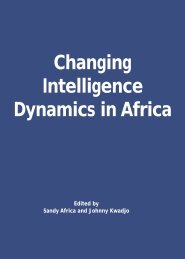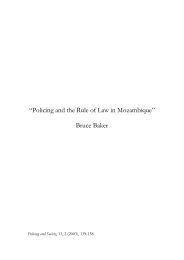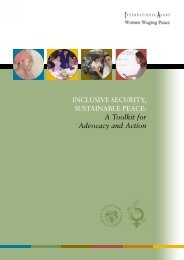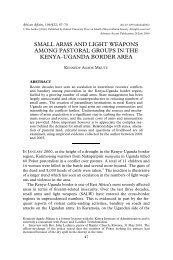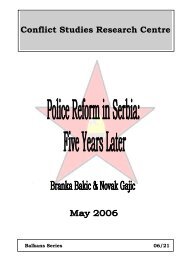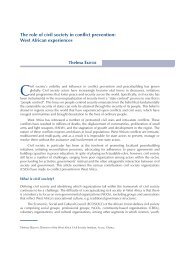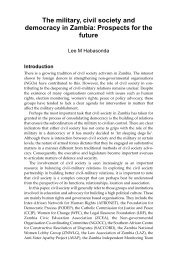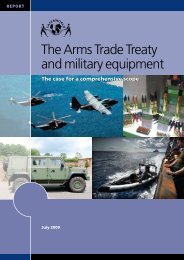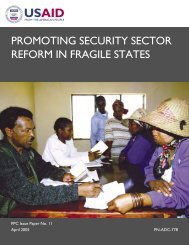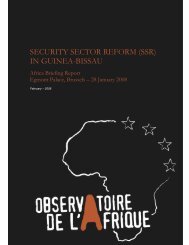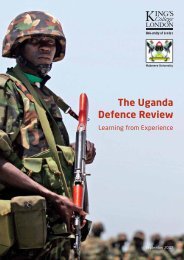AFGHANISTAN'S ELECTION CHALLENGES
AFGHANISTAN'S ELECTION CHALLENGES
AFGHANISTAN'S ELECTION CHALLENGES
You also want an ePaper? Increase the reach of your titles
YUMPU automatically turns print PDFs into web optimized ePapers that Google loves.
Afghanistan’s Election Challenges<br />
Crisis Group Asia Report N°171, 24 June 2009 Page 8<br />
None of the three laws governing the conduct of polls<br />
– the Electoral Law, the Political Parties Law and the<br />
Independent Electoral Commission Structure Law –<br />
have yet been enacted in revised form, stalled largely<br />
through government efforts. Because no electoral law<br />
can be changed less than a year before the end of the<br />
legislative term, 59 there is no time for revision even<br />
for the 2010 parliamentary polls. Ensuring that a more<br />
comprehensive and robust framework is in place for<br />
future elections is vital and must be the subject of<br />
wide public consultation by the National Assembly.<br />
1. 17The Electoral Law<br />
The difficulties with the SNTV electoral system were<br />
clear during the last provincial council and National<br />
Assembly elections; this was the most pressing issue<br />
to tackle in a revised law. Large multi-member constituencies<br />
see representatives winning seats with<br />
wildly varying mandates. The absence of disciplined<br />
political parties to carefully analyse prospects and<br />
correctly limit candidates and apportion supporters can<br />
mean inequitable political representation. For instance<br />
there can either be large numbers of “surplus” votes for<br />
individual candidates or political groups can split their<br />
votes too far between multiple candidates and get far<br />
fewer seats than their power base represents. Having<br />
individual, as opposed to party-based, candidates further<br />
leads to large, unwieldy ballot papers – some up to<br />
seven pages long in the 2005 polls – problematic both<br />
for voters and electoral administrators.<br />
There was some early debate at the IEC about a mixed<br />
proportional system, but in the end only SNTV was<br />
placed before the Wolesi Jirga in the revised law. 60<br />
Despite Qanooni’s bitter complaints about SNTV and<br />
considerable work on alternative systems at the committee<br />
level, the house acquiesced, most likely after<br />
behind-the-scenes deal making. Only minor tinkering<br />
59 Article 109 of the constitution.<br />
60 “After extensive consultations with civil society, parliamentarians<br />
and international stakeholders, the IEC made<br />
initial recommendations to the Ministry of Justice on amending<br />
the existing Election Law. These recommendations included<br />
a mixed electoral system combining the Single Non-<br />
Transferable Vote (SNTV) with a Proportional Representation<br />
(PR) system. After consultation with the Afghan government,<br />
the IEC resubmitted two separate versions of its<br />
recommendations – one version reflected the SNTV system<br />
while the other proposed a mixed proportional representation<br />
system based on closed lists. The decision has been left to<br />
the MOJ and the Cabinet as to which of the proposed electoral<br />
changes will be referred to the National Assembly for<br />
consideration”. “Elections White Paper. Supporting Feasible,<br />
Sustainable and Affordable Elections in Afghanistan”, Election<br />
Working Group paper for JCMB V, April 2007, p. 1.<br />
was proposed, such as dividing some of the larger<br />
provinces into two constituencies for National Assembly<br />
polls and party membership to appear on the ballot if<br />
desired. The Wolesi Jirga also proposed that the vote<br />
count be moved to the district level in response to the<br />
long delays and accusations of fraud at the provincial<br />
count centres in 2005. It also suggested a higher number<br />
of supporters and a larger deposit be required of<br />
presidential candidates.<br />
To date, the proposed law remains stuck in the lower<br />
house over the continued inclusion of the controversial<br />
provision of ten seats in a national constituency for<br />
Pashtun Kuchis (nomads). 61 Some believe this was<br />
aimed at helping tilt the Wolesi Jirga in Pashtuns’<br />
favour, prompting a five-week walkout in 2008. A<br />
commission established to look into the issue has so<br />
far failed to come up with an acceptable compromise.<br />
2. 18The Independent Election Commission<br />
Structure Law<br />
In the 2005 polls the president had the sole right to<br />
appoint the Independent Election Commission. 62<br />
With the formation of the National Assembly, the<br />
Post-Election Strategy Group strongly argued that, in<br />
accordance with international best practice, elected<br />
representatives should be consulted on nominations to<br />
guard against partisan membership – or perceptions of<br />
63<br />
it.<br />
When the law came before the Wolesi Jirga without<br />
such a provision the house tried – quite reasonably –<br />
to assert its right of approval over presidential IEC<br />
appointees. This provision was contained in the final<br />
61 The constitution states that members shall be “proportionate<br />
to the population of each constitutency” and the<br />
election system shall provide “general and fair representation<br />
for all the people of the country”. Article 83. For further<br />
discussion of the controversial provision of special<br />
seats for Kuchis see Crisis Group Report, Afghanistan’s<br />
New Legislature: Making Democracy Work, op. cit.<br />
62 Presidential Decree No. 23, “The Structure and Working<br />
Procedure of the Independent Election Commission”, 24<br />
January 2005, states that the chairman heads the IEC, which<br />
also has a vice-chairperson and members appointed for three<br />
years. They must act free of governmental or outside influence<br />
and are forbidden from assuming high public office for<br />
one year after the end of their term. Decisions are made by<br />
a two-thirds majority.<br />
63 It had specifically recommended that election commissioners<br />
be appointed by the president from a list approved<br />
by two-thirds majority of the Wolesi Jirga and Meshrano<br />
Jirga, following submissions by a nominating committee<br />
with civil society representation. “Post-Election Strategy<br />
Group Progress Report”, op. cit., pp. 19-20.



